Suva recommends FFP masks with head straps
In addition to FFP2 and FFP3 masks with headgear, those with ear loops are also available today. Suva continues to recommend masks with head straps for work, because they are less prone to errors during application.

As a result of the corona pandemic and the massive increase in demand for FFP2 masks, various new mask manufacturers entered the market in spring 2020. In addition to the already established FFP2 masks with head straps, FFP2 masks with ear loops are now also available. Nevertheless, Suva recommends that companies continue to provide their employees only with FFP2 and FFP3 masks with head straps, as they did before the pandemic. These are less prone to errors in use and generally fit closer to the face.
Test results speak for headband masks
As the market regulator of FFP masks used in occupational contexts, Suva has intensified its inspection activities since the outbreak of the coronal pandemic and has tested FFP2 masks with ear loops and with headbands. The evaluation of our extensive testing of over 100 FFP2 masks has shown that headband masks generally offer better protection than ear loop masks.
Ear loop masks are more error-prone in use
The reason for this is not a reduced quality of the filter material in ear loop masks, but that these are more difficult to handle and therefore more prone to errors in use than headband masks. An FFP mask can only develop its protective effect if it sits close to the face. At the same time, face shapes are very different.
Laboratory tests with various test subjects have shown that ear loop masks lead to very different and sometimes unsatisfactory results depending on the shape of the face - even though the test subjects were wearing ear loop masks from the same production batch.
On the other hand, Suva found that the FFP2 masks tested with headgear gave much more consistent test results regardless of the different face shapes: With headbands, the masks fit closer to the face and thus protect better than masks with ear loops.
How do I do a seal seat check?
When checking the seal, exhale strongly while wearing the mask and observe the airflow, especially at the nose and chin, to compare different models. Also be sure to tighten the straps on headgear masks as needed.
Whether FFP masks with headgear or ear loops are used, the manufacturer's operating instructions must always be followed.
Tips for best possible respiratory protection
- Not every respirator fits every face. Order samples and have your employees perform fit checks to find out which products fit your employees' face shapes.
- The design of the FFP mask (vertical wrinkle mask, horizontal wrinkle mask, cup shape, etc.) also affects how close the mask sits to the face.
- Shape the nose clip so that the mask seals well.
More information
How to recognize correct FFP2 or FFP3 respirators.









